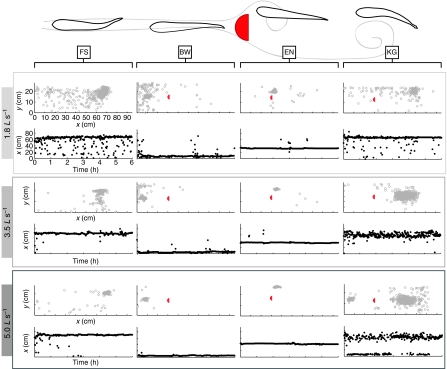Fig. 2.
Illustration of four behaviors: free stream swimming (FS), bow waking (BW), entraining (EN) and Kármán gaiting (KG). Each column contains paired graphs showing the x–y position of the head in the respirometer (top, gray circles) and the downstream position of the head over time (bottom, black dots). For all behaviors except Kármán gaiting, the spatial range of fish distribution contracts as flow velocity increases. Fish swimming in the free stream at 1.8 L s–1 periodically explored the respirometer throughout the experiment but preferred the back corner that is furthest away from the observers. As flow velocity increased, fish spent less time exploring and restricted their positions to smaller areas. This trend was even more striking during bow waking and entraining in the presence of a cylinder. Fish only Kármán gaited continuously at 3.5 L s–1, did not Kármán gait at 1.8 L s–1 and did so part of the time at 5.0 L s–1. Note that at 5.0 L s–1 Kármán gaiting fish are often impinged on the downstream baffle (i.e. downstream of the 80 cm mark) or burst upstream to bow wake. Data shown are from one representative individual. The red semicircle indicates the position of the D-section cylinder.

